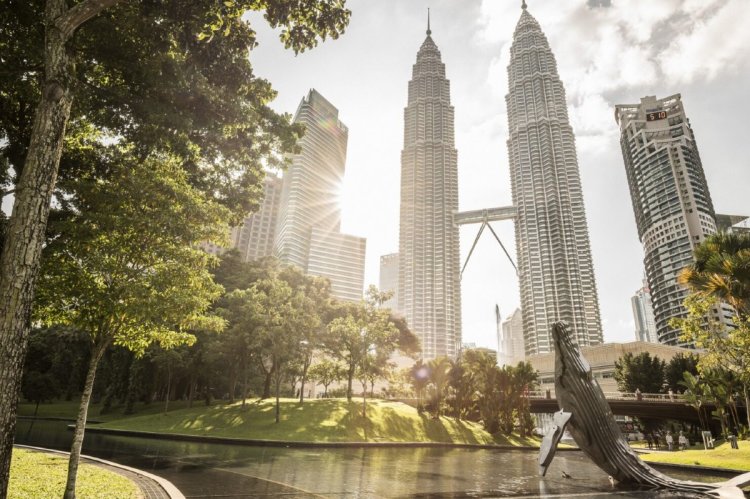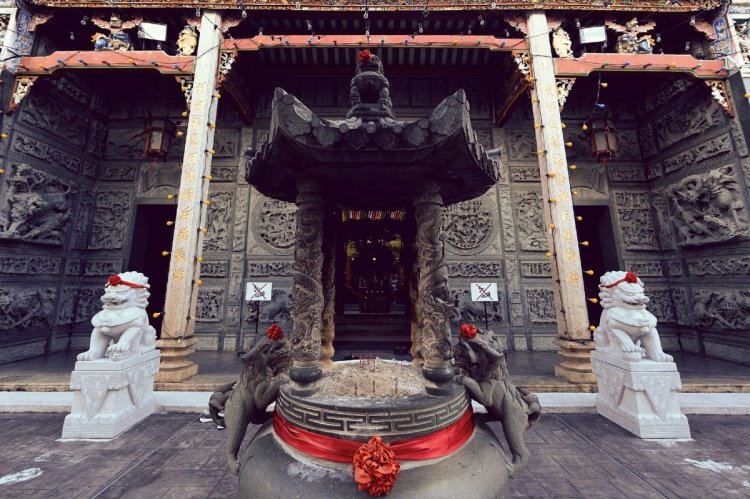The Great Journey Through Malaysia
Fly and stay - in our guide to Malaysia

Malaysia is one of the most mysterious and interesting countries in Southeast Asia, which travelers often skip or use only as a transit point. However, it is worth stopping here: Malaysia will surprise both experienced tourists and digital nomads. There are many modern and beautiful skyscrapers, restaurants with exotic and modern cuisine, picturesque natural routes for hiking and trekking, as well as beaches and surfing schools. Let's figure out which places in Malaysia are definitely worth visiting.
Kuala Lumpur

This is the largest and most developed city in Malaysia, where you can find bars on the roofs of skyscrapers, swimming pools with panoramic views, fine dining restaurants, as well as green gardens and parks with exotic birds. The hallmark of the city and the first thing that comes to mind when talking about Kuala Lumpur is the Petronas Twin Towers. The city's architecture is diverse: it intertwines Islamic buildings, traditional Malay elements, traces of British colonial influence, Hindu temples, as well as art deco and modernist styles.
A few dozen minutes by train from Kuala Lumpur is one of the key natural and religious attractions of Malaysia - the Hindu shrine of Batu Caves. This complex consists of natural caves and colorful temple structures built among dense jungle, and the main feature of this eclectic ensemble is a huge gilded statue of the god Murugan.
Things to remember in Kuala Lumpur

- Enjoy panoramic views of the city from the Merdeka 118 observation deck or the Petronas Twin Towers. A visit to the top floor of the Petronas and the bridge between them takes about 30-40 minutes and costs only 100 ringgit (approximately $20).
- Take a break from the heat in the tropical garden at the foot of the two towers.
- Enjoy a cocktail at SkyBar on the 33rd floor with views of the Petronas Twin Towers or at the highest bar in the city, Vertigo on the 54th floor.
- In the evening, order fresh seafood cooked right in front of you and try durian, Asia’s most controversial fruit, at Jalan Alor food street.
- Meet other travellers and expats at the bar street of Changkat Bukit Bintang and be sure to check out Pisco bar and Pinchos.
- Visit the Old Railway Station, a striking example of neo-Moorish architecture, unusual for Malaysia. You’ll also love the Sultan Abdul Samad City Theatre buildings and the Jamek Mosque.
- Watch the sunset at Lake Gardens, a local Versailles, a garden and park complex surrounded by skyscrapers.
- Get a taste of Chinese culture in Chinatown: visit the Central Market, the main Buddhist temple Thean Hou Temple, the Moontree House cafe and bookstore, and the Purple Cane tea shop. For dinner, be sure to visit the street restaurant Han Kee, which serves excellent Peking duck.
- Then head to Little India on Brickfields Boulevard, where there are markets, shops, and restaurants of the Indian community.
Putrajaya

This small city is the administrative center of the country, as all government residences were moved here from the capital in the 1990s. You can get to the satellite city of Kuala Lumpur by train, bus or even by bike - it will take very little time. Putrajaya is famous for its magnificent Pink Mosque, built from a unique pink granite, inspired by the Sheikh Omar Mosque in Baghdad.
Don't forget to stroll through the beautiful gardens of the city, such as the Botanical Garden, and at sunset, take a boat or a ship on the artificial Putrajaya Lake, enjoying the view of the residence of the Prime Minister of Malaysia.
Malacca

Interestingly, there are virtually no real Malays in this city: its population consists of descendants of European colonizers from Britain, Portugal and the Netherlands, as well as early Chinese immigrants. Malacca was once one of the largest trading ports in Southeast Asia, and today the city’s historic center attracts tourists with its places that testify to its former wealth. Among them are the ruins of the Portuguese fortress of Formosa, the City Hall (an example of the architecture of the United Provinces of the 17th century), St. Paul’s Church, built in the 1520s, the Chinese cemetery of Bukit Cina with tombstones from the Ming Dynasty, the Buddhist Temple of the Green Clouds, the Palace of the Sultans, Red Dutch Square and the Stadthaus (which houses the historical and ethnographic museums), as well as the Maritime Museum, which is an exact replica of the Portuguese long-distance ship Flor de la Mar. Don't forget to check out Jalan Neng Jebat, where you'll find many antique shops selling treasures dating back more than three centuries.
From Malacca, you can head to a stunning hiking spot – Taman Negara National Park, a dense tropical forest that is home to many species of exotic animals and birds. Many people prefer to raft along the rivers rather than walk, and you can understand them, because the views are simply mesmerizing! The rivers also take you to an authentic aboriginal village located within the park.
George Town

The capital of Penang is a UNESCO World Heritage Site, with eclectic old buildings that reflect both eastern and western heritage. Highlights include England’s Fort Cornwallis, Chinatown with its array of shops, cafes and restaurants, and St George’s Church, the oldest in the country. Don't miss the extraordinary temples of Wat Chaiyamangkalaram, Sri Mariyamman and the Temple of the Dragon of the Mountains, as well as the E&O Hotel, once considered the best "beyond Suez" and popular with celebrities such as Hermann Hesse, Rudyard Kipling and William Somerset Maugham. Georgetown is also home to many restored Chinese mansions, now home to museums, restaurants and private galleries

George Town is a great base for exploring Penang Island. Here you can visit the Snake Temple, also known as the Azure Cloud Temple, a traditional Chinese-style temple. Hundreds of snakes gather here because, according to legend, the founder of the sanctuary provided shelter to all living creatures. There is a snake farm nearby, where you can see not only snakes, but also monkeys and turtles.
Don’t miss the opportunity to visit the country’s largest religious site, the impressive and extravagant Kek Lok Si Temple, hidden in the rainforest. This bright and unusual temple, with a 36-meter statue of the Goddess of Mercy and a seven-tiered pagoda, was built over four decades in the late 19th and early 20th centuries.
Kuala Terengganu

The city on the east coast of the country attracts primarily sailing enthusiasts, as it is home to the best schools for learning to sail and hosts major international competitions. Among the interesting sights, it is worth highlighting Chinatown, the central market Pasar Payang, the Sultan's palace Istana Maziya, the Crystal Mosque with its mirrored panels, the Islamic Heritage Park with miniature copies of the most significant mosques in the world and the snow-white Floating Mosque.
Since the city is located on the coast, it is surrounded by islands where Malays and tourists flock for a beach holiday: Perhentian, Kapas, Bidong and Duyung. Divers especially appreciate Pulau Redang, known for its rich underwater world.
Langkawi Archipelago

Four inhabited islands and about a hundred uninhabited ones in the Strait of Malacca in the Andaman Sea are a popular place for beach holidays and surfing among Malaysians. This paradise is almost untouched by civilization, but the main resort of the archipelago, also called Langkawi, has a well-developed tourist and hotel infrastructure. There is no public transport, so you can move around by taxi, scooter, bicycle or on foot, which contributes to the purity of the air. The snow-white sands of the local beaches are rich in minerals and magnesium, which makes them healing. It is noteworthy that due to the proximity to the equator, there is no rainy season. In addition, Langkawi is a duty-free trade zone.
If you want to explore the islands, you will find caves, beaches with black volcanic sand, dense tropical forests with monkeys and impressive waterfalls. For example, popular with tourists is the 30-meter-high Seven Wells Waterfall, consisting of seven natural pools in which you can swim. The small island of Dayang Buntin in the west of the archipelago is reminiscent of the landscapes of Thailand and is famous for its small lake, known as the Lake of the Pregnant Maiden (according to legend, it helps in the treatment of infertility). And, of course, you should definitely walk across the Sky Bridge - a cable-stayed bridge thrown over a picturesque gorge 700 meters deep, where visitors often find themselves literally among the clouds.
Borneo Island

This is the third largest island in the world, divided between Malaysia, Indonesia and Brunei. Its territory is famous for its amazing exotic nature: in the jungle you can see wild orchids, Rafflesia arnoldii (the largest flower on the planet), carnivorous nepenthes, and also meet flying foxes, gibbons, leopards, rhinoceroses and elephants, not to mention the funny endemic proboscis monkeys.
The island has many mountainous landscapes, and the highest peak, Kinabalu, is located on the Malaysian side, and is often visited by climbers. If you just want to enjoy nature, go on a safari or hike in the Kinabalu National Park (in Sabah), explore the cave national parks of Niah and Gomatong or visit the rocky Gunung Mul National Park, cut by many karst grottoes and underground passages.
Other activities in Borneo include visiting the Mari Mari cultural village, which showcases the local way of life, taking a jungle tour along the Kinabantagang River, visiting the Sepilok Orangutan Rehabilitation Centre, taking a dip in the healing hot springs of Zabastok and taking a boat ride to the coral island of Pom Pom, home to green and hump-nosed turtles.
Explore amazing Malaysia and discover this beautiful country from different sides with mobile internet from fedafone to always stay connected!







